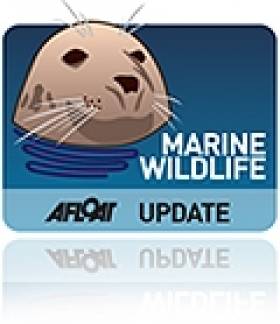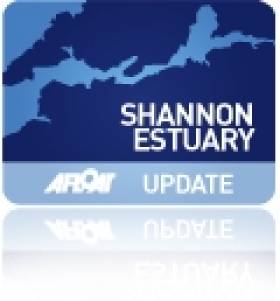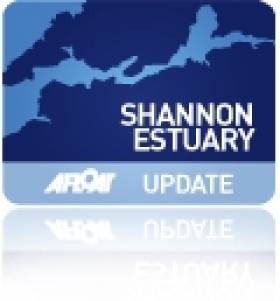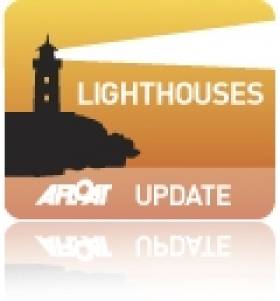Displaying items by tag: Shannon Estuary
Foynes Yachts Take Line Honours in Cappa Race
#foynes – The last long race of the Foynes Yacht Club season took place last Sunday to the Clare coastal village of Cappa for members of Foynes Yacht Club writes Gerry Ryan.
The Officer of the Day, Ger Reidy sent the fleet from Cooleen Point racing at 10am.
A total of nine yachts took this scenic race on the Shannon Estuary, where as you near Cappa, the monastic Scattery Island, Loop Head and Carrigaholt can be seen.
Crews were mixed on the different vessels, with teenagers from the sailing school and adults competing.
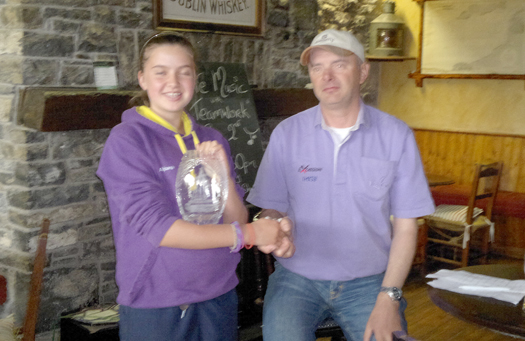
Crew member of Alpara, Mary McCormack receives the Sean Keating trophy
Unfortunately, skippers had to contend with light south-westerly winds, which took the vessels that bit longer to reach their destination.
The trophies that were raced for were the Galleon Cup and the Sean Keating trophy.
The yacht Battle were victorious on corrected time to win the Galleon Cup; second was John Conway on Golden Kopper and third, Team Foynes on Dexterity.
For the White Sails division, who were racing for the Sean Keating trophy, James McCormack on Alpara took line honours with closely followed in second by Pat Finucane on Marengo and third, Jessica Leigh.
At the presentation of prizes in the Galleon Inn, sailing captain, Liam Madden thanked all the participants who took part in the first race of the September series.
Racing continues every Sunday for the month with first gun at 2pm. Crews are asked to be at the marina at 1pm.
P&O Cruises Adonia Calls to Foynes
#SHANNON CRUISECALL – P&O Cruises Adonia is visiting the mid-west port of Foynes on the banks of the Shannon port today, writes Jehan Ashmore.
She had made a call to the east coast last week in Dublin Port and the 30,277 tonnes vessel is the second caller so far this year to visit the Shannon region, when the ultra-luxurious Silver Whisper docked in the Co. Limerick port in mid-May.
A further two cruise callers are scheduled, as Le Diamant is also due to call this week on Thursday. The final caller is Amadea, which is expected to close the season next month.
All cruise callers will dock in Foynes which is one of six port facilities along the Shannon Estuary which is under the control of the Shannon Foynes Port Company (SFPC).
Dolphin Group Celebrates Ireland's First Refloating Success
#MARINE WILDLIFE - A stranded dolphin has been successfully refloated for the first time ever in Ireland thanks to the efforts of volunteers with the Irish Whale and Dolphin Group (IWDG).
As the Irish Examiner reports, the group was alerted by a woman who saw the 3.5-metre bottlenose dolphin on a beach at Béal on the Shannon Estuary in north Kerry on 1 June.
Volunteers on the scene discovered the female dolphin's skin was still moist, which indicated it had only recently stranded.
After checking for injuries, the team decided not to wait for special whale pontoons to arrive from Kilrush and instead used a local farmer's tractor and low loader to lift the dolphin out of the sand.
The dolphin was slowly moved back to the water, where she was stabilised before she regained composure and was able to swim away.
Images of the dolphin's dorsal fin were captured by the volunteers for the IWDG's records, which enabled researchers to confirm subsequent sightings among a pod of some 140 dolphins swimming in the estuary - with the latest spotting on 27 June on a dolphin-watching boat trip, where she appeared to be in good health.
In a statement, the IWDG said: "The loss of one dolphin, especially an adult female, could have a significant impact on this population, thus highlighting the importance of the prompt action on the shore at Béal."
Midsummer Night Cruise on Shannon Estuary Postponed
#MARINE WILDLIFE - Dolphinwatch Carrigaholt has postponed its midsummer night cruise on the Shannon Estuary for a second time due to poor weather.
As previously reported on Afloat.ie, the nighttime cruise to raise funds for the Irish Whale and Dolphin Group will visit caves off North Kerry, sea stacks and headlands and the mighty Loop Head, including the giant sea stack known as Dermot and Grainne’s Rock (or Cuchalain’s Leap) and Black Rock with its fantastic seabird colonies.
Along the way you will also expect to see marine wildlife such as bottlenose dolphins, and enjoy a vegetarian or seafood platter with live traditional music on board.
Organisers hope that better weather will allow them to hold the cruise next weekend on Saturday 21 July. For more information call 087 917 5984 or email [email protected].
Foynes Flying Boat Museum Flies High
#foynes – The Foynes Flying Boat Museum took a major step toward receiving full accreditation from the Heritage Council under a programme that aims to raise minimum standards in the sector.
The County Limerick tourist attraction, which entered the Museum Standards Programme for Ireland (MSPI) in 2010, was presented with interim accreditation by Minister for Arts, Heritage and Gaeltacht Affairs, Jimmy Deenihan at a ceremony in the Architectural Archive in Dublin this week. Minister Deenihan said the accreditation was being presented for excellence in caring for the collection, museum management, education, exhibitions and visitor services.
Administered by the Heritage Council, the voluntary programme includes seven categories consisting of 34 standards, 25 of which are interim standards and nine are full. Nationally to date,15 museums have achieved full accreditation and 10 have received interim accreditation.
'Museum Standards for Ireland, working towards the care of Ireland's heritage, certify Foynes Flying Boat Museum has been awarded Interim Accreditation in the Museum Standards Programme for Ireland
Cathaoirleach of Limerick County Council, Cllr. Jerome Scanlan congratulated the staff and Board of Foynes Flying Boat Museum for their continued efforts to further enhance the West Limerick museum's status as one of Ireland's leading visitor attractions.
"In receiving this accreditation, the management and staff of the Museum have once again underlined their commitment and creative approach to remembering and celebrating Limerick's and Ireland's unique position in aviation history. As a result, the story that this museum first told remains as fascinating today as it did when the facility was established in 1989," stated Cllr. Scanlon.
He added: "From the installation of the replica Yankee Clipper to the completion of works on the reinstated control tower, those involved with the Museum have helped to conserve and protect a key part of the history and heritage of the local area. Limerick County Council is committed to continuing its support for a project that has produced huge dividends for the local economy and the tourism product that County Limerick has to offer."
Reacting to the news, Museum Director Margaret O'Shaughnessy said: "I'm absolutely delighted we have achieved this accreditation. It presents further recognition of the quality museum that is operated by staff and the Board of Directors. It is especially pleasing that we have secured interim accreditation under the MSPI less than two years after we commenced our participation in the programme."
Ms. O'Shaughnessy explained that the Museum will seek to receive full accreditation before the end of 2013.
"The 25 interim standards that we have already achieved are wide ranging and have helped to further enhance the product on offer at the museum. They include a strategic management plan for next three years, a financial plan, safeguarding the condition of the museum collection, the cataloguing of the collection, presentation of collections, development of community education initiatives, and the development of a comprehensive visitor care and access plan."
Last March, the Museum launched the country's First National Aviation Hall of Fame Award. Dr. Tony Ryan, who as founder of Guinness Peat Aviation became the museum's first sponsor, was the first recipient of the National Aviation Award.
Joyriders Out in Front at WIORA on the Shannon Estuary
#WIORA – In an ebb tide the West of Ireland Offshore Racing Championship's hosted by Foynes Yacht Club got off to a terrific start yesterday on the Shannon Estuary. Race Officer, Liam Dineen set a challenging course for some of the classes. Competitors who travelled from Sligo to Mountshanon, enjoyed fine sailing in a steady north-westerly winds of 30 knots that kept the four fleets entertained for the passage race, which was raced east of Foynes Island to the Loughill navigation buoy.
Results:
Class 1 IRC: 1st Joyrider, 2nd Mustang Sally, 3rd Dexterity.
Echo: 1st Mustang Sally, 2nd Joyrider. 3rd Dexterity.
Class 2 IRC: 1st Dis-A-Ray. 2nd 2602. 3rd Golden Kopper.
Echo: Dis-A-Ray. 2nd 2602. 3rd Golden Kopper.
Class 3 IRC: 1st Reconnaissance. 2nd Jaws. 3rd Battle.
Echo: 1st Reconnaissance. 2nd Jaws. 3rd Battle.
Whiite Sails Division One: 1st Serendipity of Solent. 2nd Wyte Dolphin. 3rd Kerry Dream.
White Sails Division Two: 1st Alpara. 2nd Jabiru. 3rd Sea Saw.
Midsummer Night Cruise on Shannon Estuary Next Weekend
#MARINE WILDLIFE - Dolphinwatch Carrigaholt, in collaboration with the Irish Whale and Dolphin Group (IWDG), is offering a special midsummer night cruise in the Shannon Estuary as a fundraiser for the IWDG.
The cruise will depart Castle Pier in Carrigaholt, Co Clare at 5pm on Saturday 30 June (weather permitting), returning around 10pm,
During the trip you will visit caves off North Kerry, sea stacks and headlands and the mighty Loop Head, including the giant sea stack known as Dermot and Grainne’s Rock (or Cuchalain’s Leap) and Black Rock with its fantastic seabird colonies.
Along the way you will also expect to see marine wildlife such as bottlenose dolphins, basking sharks - and possibly even a minke whale, if a recent coastal sighting is anything to go by.
Included in the cost is a vegetarian or seafood platter and wine onboard sponsored by The Long Dock in Carrigaholt, as well as live traditional music and a €10 voucher for fine art prints and books from Carsten Krieger Photography.
Tickets for the cruise are priced at €50 for IWDG members, €60 for non-members not wishing to take out membership and €70 for non-members including a one-year IWDG membership (normally €30).
Numbers on this adults-only cruise are limited to just 35 - so book early to avoid disappointment. To book your place call 087 9175984 or e-mail [email protected].
Shannon Estuary Venue for Mermaid Munster Championships
#SHANNON ESTUARY – This coming bank holiday weekend the Munster Mermaid Championships will take place at Foynes Yacht Club with an entry of 15 boats so far writes Gerry Ryan.
Racing will take place over two days, one race on Saturday and two on Sunday are scheduled.
Expected from the east coast are eight craft to participate in the championships, which they have been coming to this event for the last number of year's.
The Foynes Irish Coffee festival is co-inciding with the chamionships and Foynes club will have a 'Fun on the Water Day' at 4pm on Sunday afternoon and lots of events to entertain the public during the festival.
The Irish Naval patrol ship, the L.E. Orla will be berthed in the Docks, where member's of the public are invited for an inspection.
#FOYNES YC – On Sunday last Foynes Yacht Club on the Shannon Estuary celebrated Commodore's Day, which was a very nostalgic event, because a special handsewn tapestry with the club logo, and with the words 'Foynes yacht club' and the year when the club started 1962-2012 were specially embroided by Teresa Kirwan, who received a lot of praise from all who attended on the day writes Gerry Ryan.
A course for racing was set by Officer of the Day, Alan McEneff in the harbour area for all classes, and all boats were decked out with bunting to add colour to the proceedings.
Unfortunately, the race had to be abandoned due to the lack of wind.
Nevertheless, it was a very nostalgic day, because past Commodore's received gold medals to commemorate their achievement's in the club over the last 50 years.
The former Commodore's who were presented with specially commissioned medals were Bobby Mulrooney, David Floyd, Jim Collier, Charlie McGibney, Paddy McNamara, Pat Moran, John Conway, Frank Dennison, Pat Finucane, and present Commodore Tom Murray.
Commodore Tom Murray in his opening remarks spoke about the vision and philosophy that the former Commodore's who came before him achieved in getting sailor's and member's to join this great club.
He said Foynes Yacht Club could not go on except for the member's volunteering in taking on different tasks during the year to ensure the club stood up to the test of time.
'Training for the juveniles has been to the forefront of the club for a number of year's, and this is going from strength to strength, the youht's are the backbone to every club, and it is great to see so many of them here today', added the Commodore.
In his closing remarks Commodore Murray spoke about the West of Ireland Offshore Championships, which he hoped to have 50 boats for this occasion to coincide with our golden jubilee. The championships are scheduled to take place in July.
The annual blessing of the boats was performed by Fr. Noonan, P.P., Foynes, and after this ceremony a Bar-B-Que was held on the club lawn, where chef's Donal McCormack, John-Paul Buckley, Paddy McSweeney, Bev Lowes and Alan McEneff cooked to the delights of the hungry member's and friend's. Well done to the social committee in preparing the salads to accompany the burgers.
This weekend we will be hosting to first leg of the Estuary Bell, two races are down for Saturday and one on Sunday. Class 1, 2 and White Sails will be competeing for the coveted trophy, and it is envisaged that a good number of craft will be sailing. Present weather indications are for the settled weather to continue.
Taoiseach Opens Loop Head Lighthouse
#LIGHTHOUSES – Taoiseach Enda Kenny, T.D., today officially opened the new exhibition at Loop Head Lighthouse and launched the 2012 visitor season at the historic West Clare tourist attraction.
Loop Head Lighthouse, located at the mouth of the Shannon Estuary, is steeped in history and rich in maritime heritage with its origins dating back to the 1670s. The Taoiseach's grandfather was a keeper at the lighthouse. James John McGinley took up duty at the Lighthouse as Principal Keeper on 16th January 1933. He spent 1 year and 10 months at Loop Head. He was transferred from the station in October 1934.
Clare County Council, along with Shannon Development, Loop Head Tourism and the Commissioners of Irish Lights (CIL), conducted a successful 11-week trial opening scheme in 2011 that resulted in an estimated 17,000 people visiting the landmark building. It is estimated that the trial opening of the Lighthouse was worth approximately €400,000 to the local economy.
Earlier this year, Shannon Images was appointed to produce an interpretation plan that would further enhance the overall visitor experience at the lighthouse. An exhibition focusing on the history of Irish lighthouses and the people who have operated them since the 17th century has been installed for the 2012 tourist season. All materials and labour for the project were sourced locally.
Speaking at the opening, the Taoiseach said: "The opening of the 2012 visitor season at Loop Head Lighthouse marks a special day for tourism in Ireland and for the people of West Clare. It's an equally special day for me and my family. Because as I made my way here today, I was acutely aware that my journey was also a family journey. A journey that began 80 years ago, when my grandfather, James McGinley, arrived here to become the Principal Keeper at Loop Head."
Speaking at today's official opening, Mayor of Clare Councillor Pat Hayes said the Taoiseach's visit to the lighthouse was testament to the contribution made by the Lighthouse to the local community and economy since the trial opening in 2011. Mayor Hayes noted that heritage tourism could play a significant role in the revival of the domestic tourism sector.
"The collaborative approach adopted by regional development agencies and the local community to enhancing the visitor experience at Loop Head is a model that could and should be replicated elsewhere throughout County Clare and, indeed, the rest of Ireland. Heritage tourism is becoming increasingly popular throughout the world and therefore, we should consider the possibility of opening up and promoting some of other many existing heritage sites and structures that currently remain inaccessible to the public", stated Mayor Hayes.
According to Ruairi Deane, Shannon Development Tourism Product Development Executive: "Shannon Development is delighted to have worked with our partners on this unique and exciting project. The overall objective of the project partners has been to develop the Lighthouse as an anchor tourism attraction in West Clare with the potential to attract more visitors and generate additional revenue for the area, and we believe today's official opening by the Taoiseach is another major step in fulfilling this aim. The new exhibition uses a wonderful blend of multi-media to tell the story of Loop Head Lighthouse and the surrounding area."
Cillian Murphy, Chairman of Loop Head Tourism said: "The lighthouse visitor project builds on the designation of the Loop Head Peninsula as a 'European Destination of Excellence' (EDEN) by the European Commission and also links to other community projects such as the recent restoration of the World War 2 'EIRE' sign nearby. These community initiatives complement the lighthouse project and will further reinforce the Loop Head peninsula as a quality sustainable tourism destination. Tourism development on the peninsula will affect all who live here and Loop Head Tourism have shown what can be achieved by developing our tourism products in conjunction with the peninsula community and our local authorities"
Mr. Murphy expressed confidence that the Taoiseach's visit and personal connection with the Lighthouse would help to attract visitors to the area during the coming months. "Tourism operators and accommodation providers are also working closely with each other to further develop the Loop Head Peninsula's growing reputation as a tourist destination for those that wish to have a different type of Irish holiday experience and our recent appointment of a 'Tourism Animator', which is funded by a Leader grant, gives us an opportunity to take another huge step in the right direction," Mr. Murphy concluded.
The existing tower style lighthouse was constructed in 1854 and was operated and maintained by a keeper who lived within the lighthouse compound. In January 1991, the lighthouse was converted to automatic operation, and today is in the care of an attendant and is also monitored by the CIL.
Loop Head Lighthouse officially opens to the public from tomorrow (Saturday, 19 May 2012) up to 3rd September 2012, creating 12 seasonal jobs. Visit www.loophead.ie





























